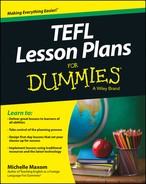Book Description
Instant English lessons - learn in a flash!
TEFL Lesson Plans For Dummies is a ready-made course manual for TEFL teachers. With fully fleshed-out lessons, activities, tools, games, and resources, this book contains what is essentially an instant TEFL course. Use the ready-made materials directly in the classroom, or follow along with the detailed planning models and frameworks to grow your skills while designing your own lesson plans more effectively. The book includes access to online materials you can print for use in class, and the lessons can be used with or without the aid of technology in the classroom. You'll find expert advice on teaching all age levels and class sizes, including ideas for taking the lessons out into the world.
Many EFL/ESL teachers have little or no experience, and may have only been in the profession for a limited time. TEFL Lesson Plans For Dummies saves the day with materials, ideas, and activities that can be implemented quickly and easily, making lessons more productive and fun. From quick exercises to larger-scale plans, this book contains hundreds of ways to help your students become more proficient English speakers.
Implement expertly-designed planning models with step-by-step advice
Teach lessons designed for students of all ages and classes of all sizes
Integrate technology when it's available, or do without it when it's not
Move your lessons outside of the classroom for deeper immersion
Whether you're taking a TEFL training course, about to head out on your first job, or a veteran of the field, this book provides you with the tools you will need to get things moving in class. If you're looking to cut down on planning time without sacrificing student engagement, TEFL Lesson Plans For Dummies is the classroom-ready resource you need.
Table of Contents
- Introduction
- Introduction
- Part I: Methodology in the Madness
- Chapter 1: Grasping The Basics Of TEFL Teaching
- Chapter 2: Adapting Recent Approaches and Methodologies to Your Work
- Knowing How People Learn, and How to Help Them Learn
- Looking at Approaches and Methodologies for Course Planning
- Killing two birds with one stone: Content and language integrated learning
- Focusing on frequently used expressions: The Lexical Approach
- Being a counsellor for your students: Community language learning
- Deciding between global English and other varieties
- Exploring a notional functional approach
- Face to face meets online tuition with blended learning
- Assessing Approaches and Methodologies for Classroom Delivery
- Using principles from the Silent Way
- Allowing students to acquire, not learn, with the natural approach
- Teaching playfully with Suggestopaedia
- Making movement part of your plan: Total physical response
- Helping students bond with NLP
- Keeping everyone interested using multiple intelligences theory
- Choosing a deductive or inductive approach to lesson plans
- Taking a task-based approach to language learning
- Chapter 3: Getting Down to Planning
- Part II: Beginner and Elementary Classes
- Part III: Pre-Intermediate and Intermediate Classes
- Part IV: Upper Intermediate and Advanced Classes
- Part V: Mixed Classes
- Part VI: The Part of Tens
- About the Author
- Cheat Sheet
